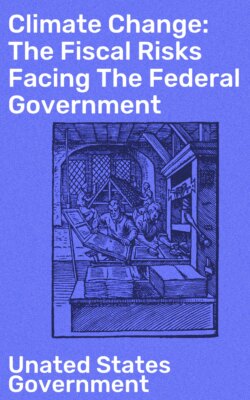Читать книгу Climate Change: The Fiscal Risks Facing The Federal Government - Unated States Government - Страница 6
На сайте Литреса книга снята с продажи.
Expenditure Impacts
ОглавлениеOn the expenditures side of the Federal ledger, each of the five program-specific assessments conducted for this report unambiguously illustrates that climate change will raise expenditures. The table below shows estimates of recurring, annual expenditures due to climate change across four of the five program areas—totaling $34-$112 billion per year by late-century, the equivalent of $9-$28 billion per year in today’s economy.
| Quantified Increases in Annual Expenditures Due to Climate Change in Modeled Scenarios[1] | ||||||
| Billions of Real dollars(GDP-Adjusted) [2] | Mid-Century | Late-Century | ||||
| Mean | Lo[3] | Hi[3] | Mean | Lo[3] | Hi[3] | |
| Wildland FireSuppression | $1.3($0.6) | $0.8($0.4) | $2.0($0.9) | $2.3($0.5) | $1.2($0.2) | $5.0($1.0) |
| Crop Insurance[4] | -- | -- | -- | $4.2($1.0) | <$0.1(<$0.1) | $9.3($2.3) |
| Air Quality-Health Care[5] | $0.6($0.3) | <0.1(<$0.1) | $1.5($0.7) | $7.7($1.2) | $0.6($0.1) | $19.7($3.2) |
| Coastal Disaster Relief | $19($8.7) | $11($5.0) | $31($14.2) | $50($13.6) | $32($8.7) | $78($21.2) |
| Total Annual Expenditures [6] | $21($9.6) | $12($5.4) | $35($15.8) | $64($16.3) | $34($9.0) | $112($27.6) |
Estimated costs reach into the tens of billions per year within just a few decades (2040–2060) and grow into late century (2060–2100). There is also evidence to suggest the costs incurred over the last decade related to extreme weather and fire have already been exacerbated by climate change.[7] Climate-related costs in these areas also appear likely to vary significantly from year to year, signaling the prospect of budgeting and other planning challenges and greater reliance on emergency supplemental appropriations. Even costs that represent a small portion of the Federal Budget can be severely challenging for individual agencies without responsive adjustments to Congressional appropriations.
In addition to these four program areas, OMB identified significant flood risks to Federal property after reviewing just a sample of the Federal inventory—including $83 billion in Federal assets located in the currently defined 100-year floodplain, $23 billion in assets located in the currently defined 500-year floodplain, and $62 billion in coastal assets that would be threatened by inundation or otherwise severely affected at high tide under a 6 foot sea level rise scenario—but has not estimated the likely costs associated with these liabilities over the coming decades.
Although the combined weight of the quantified mean expenditure estimates in the assessments in this report reaches into the tens of billions to hundreds of billions per year by late-century, this is only a narrow window into the full fiscal risks of climate change. Fiscal impacts in several areas exposed to potentially significant climate risk are not quantified in this report due to data limitations and other challenges. Among these are health care related to vector-borne diseases and other climate change health impacts, national security, the National Flood Insurance Program (NFIP),[8] transportation and water infrastructure, and inland Federal asset flood risk.
